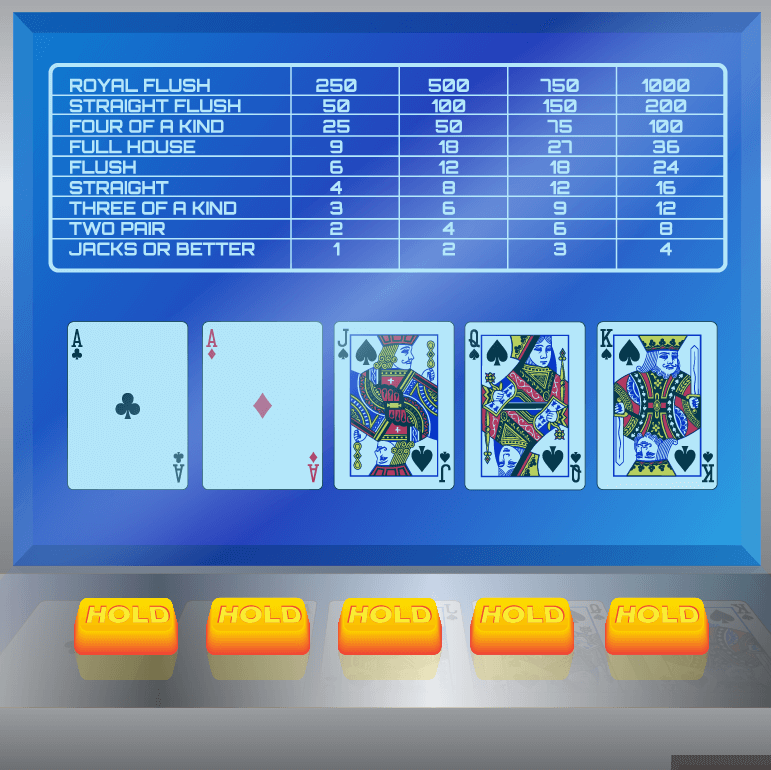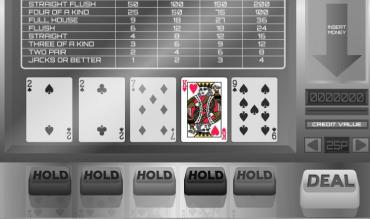Standard video poker machines are called single-play because the player plays only one game at a time. However, single-play games are not the only type of video poker game available in a casino (or online). There are also games that play three, five, 10, 50 and even 100 hands at a time.
These multiple hand games are called multiple-hand or multiple-play (or multi-hand / multi-play for short). There is nothing magical about how to play video poker multiple hand games.
HOW TO PLAY MULTI HAND VIDEO POKER GAMES
- Select number of hands you want to play (you don’t have to play the maximum number of games to get the best return).
- Select the bet per hands (always bet 5 so you don’t miss out on the royal flush bonus).
- Hit the Deal / Draw button.
- The base hand is dealt at the bottom of the screen.
- All the cards in the other hands remain face down.
- Select the card(s) you wish to hold (if any).
- These same cards in the same position will show face up in all hands being played.
- Hit the Deal / Draw button.
- Each of the hands being played will be filled by a separate deck of shuffled cards.
- Each winning hand at video poker will accrue credits as if it were a single hand game. If a royal flush is dealt in the base hand (and you select all five cards), each hand will collect the 4,000 credits.
With all casino-type games there are advantages and disadvantages. Multi-hand video poker is no different.
ADVANTAGES
- Multi-hand games are plentiful, easy to find.
- Pay tables for multi-hand games tend to match those for single play games. They are not generally reduced like progressive or other special feature games.
- There is no additional bet required to turn on a special feature. You bet based on the total number of lines played.
- One of the biggest advantages of multiple hand games is that the video poker strategy for playing them is exactly the same as when playing a single-play game. There is no need to memorize a separate playing strategy. Simply look for a multiple hand (multi-hand) game that matches the game type and pay table that you normally play and use the strategy you normally use as if you are playing a single-play game.
DISADVANTAGE
- The major (really the only) disadvantage to playing multiple hand video poker games is the variance is higher than for a single hand game. This means a larger bankroll is required for playing multi-hand games when playing the same total bet per hand(s). For example, a single-play quarter game requires $1.25 per hand at the maximum of five credits per hand. A five-play nickel game also requires $1.25 total per five lines of play at the maximum bet of five credits per hand.
The higher variance may seem counter intuitive to many video poker players. Conventional logic might seem to indicate that multiple hands should smooth the variance per game because several hands are played.
Let’s look at what really happens when playing a multi-hand game.
- If you are dealt a good initial hand you can make a lot of money. Imagine your delight at being dealt four-of-a-kind, straight flush or even a royal flush.
- However, if you are dealt a poor hand, you stand to lose a lot of money. Over half of all hands in video poker end up being losers.
Now let’s look at some specifics.
SINGLE PLAY GAMES
Variance is higher when more of the return is concentrated in fewer high paying hands. For example, 9/6 jacks or better (where a full house is paid at 9-for-1 and a flush is paid at 6-for-1) has only one very high paying hand – the royal flush. The variance on this game is 19.5.
Bonus Poker is different than Jacks or Better. It pays a bonus for four aces (80-for-1 instead of 25-for-1) and four 2s, 3s or 4s (40-for-1). Payoffs for a full house and a flush are reduced to make up for the higher payoffs on the quads. The variance for 8/5 Bonus Poker is 20.9 – a seven percent increase over Jacks or Better.
Double Bonus Poker increases the bonus on four aces to 160-for-1, the bonus on four 2s, 3s, or 4s to 80-for-1, and the bonus on 5s through kings to 50-for-1. The payoff for two pairs is reduced to 1-for-1 to compensate for the increased quad payoffs. By concentrating much more of the return in fewer, large payoffs for four-of-a-kind hands and reducing the return for the more frequent lower-paying hands, variance on Double Bonus Poker soars to nearly 28.3 – a 48 percent increase from Jacks or Better.
MULTI-HAND GAMES
The base variance of the particular game increases as the number of plays increase.
The strength of each multiple-play game is determined by the initial five cards that are dealt. If it is a strong hand, each play based on that initial hand will be a strong hand. If it is a weak hand, each play based on it will be weak. For example, if the initial hand contains three 10s, the minimum each play will return is 3-for-1. If, however, the initial hand contains nothing and needs to be completely discarded, the chances for a positive outcome for this overall hand are greatly diminished.
Now let’s look at some specific games, number of plays and variances.

JACKS OR BETTER – FULL-PAY (9/6)
- Single-play variance: 19.5.
- 3-play variance: 23.4 – a 20 percent increase.
- 5-play variance: 27.4 – 40 percent greater than single-play.
- 10-play variance: 37.2 – 90 percent greater than single-play.
- 50-play variance: 115.8 – 490 percent greater than single-play.
- 100-play variance: 214 – nearly 10 times the variance of the single-play version game.
BONUS POKER – (8/5)
- Single-play variance: 20.9.
- 3-play variance: 25.1.
- 5-play variance: 29.4.
- 10-play variance: 40.0.
- 50-play variance: 124.8.
- 100-play variance: 230.8.
DOUBLE BONUS POKER – (10/7)
- Single-play variance: 28.3.
- 3-play variance: 35.0.
- 5-play variance: 41.8.
- 10-play variance: 58.8.
- 50-play variance: 194.4.
- 100-play variance: 364.0.
Those variances can, indeed become extremely high. What do they mean to you, the average video poker player?
The more knowledge you have about the game you are playing, the better prepared you are to enjoy the game. If you are planning to play multiple-play video poker you will need to bring a larger bankroll in order to play as long as could on a single-play game. Even on the relatively low variance Jacks or Better, the variance of the 100-play game is 10 times that of the single play game. This means that even if you were to play a lower denomination multiple-play version of the game you still may need a larger bankroll.
For example, if you normally play single-play Jacks or Better at the $1 level, it may seem logical that you could play 100-play Jacks or Better at the 1¢ level. After all, playing at the maximum coin-in the wager is five dollars on each total hand in either game. But, by looking at the increased variance for 100-play (10 times or more than that of single-play), it is easy to see that the same bankroll will not nearly be enough.
Keep in mind that variance can be good or bad. When riding the wave of positive variance, life is very good indeed. However, when wallowing in the pit of negative variance, life is very tough. It is always a good idea to make sure you have a large enough bankroll when you gamble. Keep your casino experiences enjoyable. Even though you do not have to learn a different strategy to play a multiple hand version of your favorite game, make sure you bring a large enough bankroll with you if you are planning to play multiple-play video poker.


